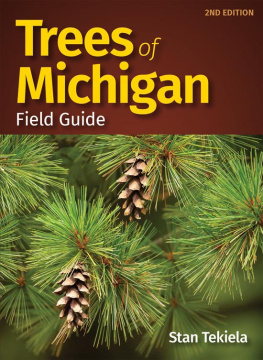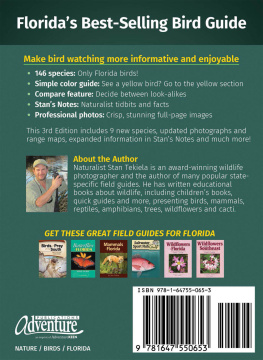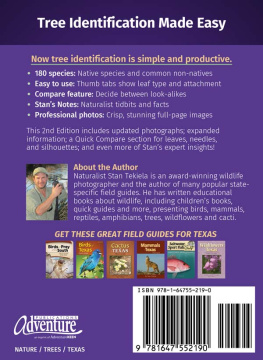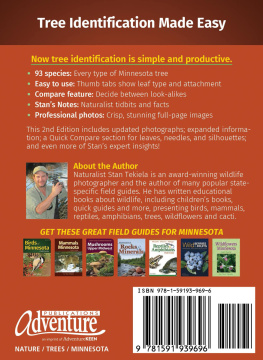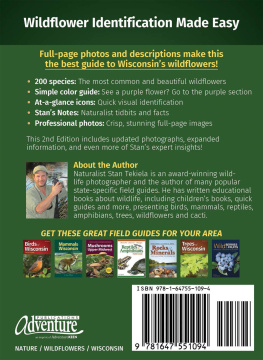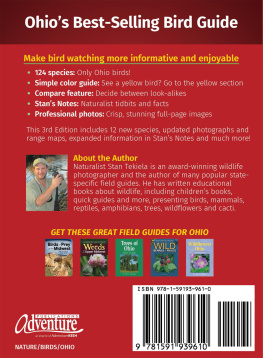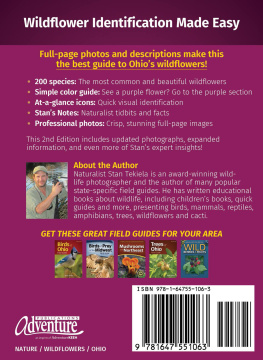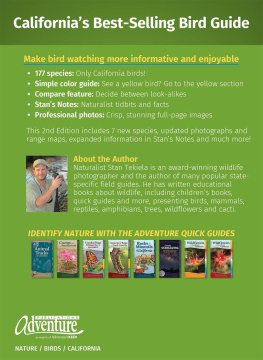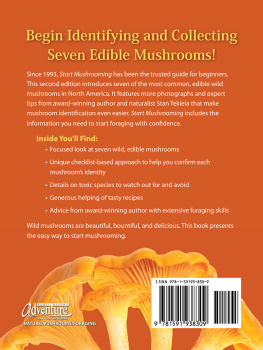Stan Tekiela - Trees of Michigan Field Guide
Here you can read online Stan Tekiela - Trees of Michigan Field Guide full text of the book (entire story) in english for free. Download pdf and epub, get meaning, cover and reviews about this ebook. year: 2020, publisher: Adventure Publications, genre: Detective and thriller. Description of the work, (preface) as well as reviews are available. Best literature library LitArk.com created for fans of good reading and offers a wide selection of genres:
Romance novel
Science fiction
Adventure
Detective
Science
History
Home and family
Prose
Art
Politics
Computer
Non-fiction
Religion
Business
Children
Humor
Choose a favorite category and find really read worthwhile books. Enjoy immersion in the world of imagination, feel the emotions of the characters or learn something new for yourself, make an fascinating discovery.
- Book:Trees of Michigan Field Guide
- Author:
- Publisher:Adventure Publications
- Genre:
- Year:2020
- Rating:5 / 5
- Favourites:Add to favourites
- Your mark:
- 100
- 1
- 2
- 3
- 4
- 5
Trees of Michigan Field Guide: summary, description and annotation
We offer to read an annotation, description, summary or preface (depends on what the author of the book "Trees of Michigan Field Guide" wrote himself). If you haven't found the necessary information about the book — write in the comments, we will try to find it.
Trees of Michigan Field Guide — read online for free the complete book (whole text) full work
Below is the text of the book, divided by pages. System saving the place of the last page read, allows you to conveniently read the book "Trees of Michigan Field Guide" online for free, without having to search again every time where you left off. Put a bookmark, and you can go to the page where you finished reading at any time.
Font size:
Interval:
Bookmark:












 In memory of my father. Edited by Sandy Livoti and Ritchey Halphen Cover/book design and leaf illustrations by Jonathan Norberg Tree illustrations by Julie Martinez Photo credits by photographer and page number: Cover photo: Eastern White Pine by Stan Tekiela Steven J. Baskauf: (fruit) Stan Tekiela: all other photos *Dembinsky Photo Associates 10 9 8 7 6 5 4 3 2 1 Trees of Michigan Field Guide First Edition 2002 Second Edition 2020 Copyright 2002 and 2020 by Stan Tekiela Published by Adventure Publications An imprint of AdventureKEEN 330 Garfield St. S. Cambridge, MN 55008 (800) 678-7006 www.adventurepublications.net All rights reserved Printed in China ISBN 978-1-59193-967-2 (pbk.), 978-1-59193-968-9 (ebook) TABLE OF CONTENTS MICHIGAN AND TREES Michigan is a great place for anyone interested in trees. With Trees of Michigan Field Guide , youll be able to quickly identify 105 of the most common trees in Michigannearly all of which are native to the state.
In memory of my father. Edited by Sandy Livoti and Ritchey Halphen Cover/book design and leaf illustrations by Jonathan Norberg Tree illustrations by Julie Martinez Photo credits by photographer and page number: Cover photo: Eastern White Pine by Stan Tekiela Steven J. Baskauf: (fruit) Stan Tekiela: all other photos *Dembinsky Photo Associates 10 9 8 7 6 5 4 3 2 1 Trees of Michigan Field Guide First Edition 2002 Second Edition 2020 Copyright 2002 and 2020 by Stan Tekiela Published by Adventure Publications An imprint of AdventureKEEN 330 Garfield St. S. Cambridge, MN 55008 (800) 678-7006 www.adventurepublications.net All rights reserved Printed in China ISBN 978-1-59193-967-2 (pbk.), 978-1-59193-968-9 (ebook) TABLE OF CONTENTS MICHIGAN AND TREES Michigan is a great place for anyone interested in trees. With Trees of Michigan Field Guide , youll be able to quickly identify 105 of the most common trees in Michigannearly all of which are native to the state.
This guide also includes a number of common non-native trees that have been naturalized in Michigan. This book makes no attempt to identify cultivated or nursery trees. Because this book is a unique all-photographic guide just for Michigan, you wont have to page through photographs of trees that dont grow in the state or attempt to identify live trees by studying black-and-white line drawings. WHAT IS A TREE? For the purposes of this book, a tree is defined as a large woody perennial plant, usually with a single erect trunk, standing at least 15 feet (4.5 m) tall, with a well-defined crown. Trees of Michigan Field Guide helps you observe some basic characteristics of trees so you can identify different species confidently. HOW THIS BOOK IS ORGANIZED To identify a tree, youll want to start by looking at the thumb tabs in the upper right-hand corner of the text pages.
These tabs define the sections of the book. They combine several identifying features of a treemain category, needle or leaf type, and attachmentinto one icon. Its possible to identify trees using this field guide without learning about categories, leaf types, and attachments. Simply flip through the pages to match your sample to the features depicted on the thumb tabs. Once you find the correct section, use the photos to find your tree. Or you may want to learn more about the features of trees in a methodical way, using the following steps to narrow your choices to just a few photos.
First, determine the appropriate section and find the right icon by asking these questions: Is the tree coniferous or deciduous? If its a conifer, are the needles single, clustered, or scaly? If its deciduous, is the leaf type simple, lobed, or compound, and do leaves attach to twigs in an opposite or alternate pattern? Next, simply browse through the photos in that section to find your tree. Or, to further narrow your choices, use the icon in the lower right-hand corner of the text pages. These icons are grouped by the general shape of the needle or leaf and increase in size as the average size of the needle or leaf increases. Finally, by examining the full-page photos of needles or leaves, studying the inset photos of bark, flowers, fruit, or other special features, and considering information on text pages, you should be able to confidently identify the tree. While these steps briefly summarize how you can use this book, it is quite helpful to learn more about how the sections are grouped by reading the Identification Step-by-Step section. IDENTIFICATION STEP-BY-STEP Conifer or Deciduous Trees in this field guide are first grouped into two main categories that consist of 16 conifers and 89 deciduous trees.
Trees with evergreen needles that remain on branches year-round and have seeds in cones are conifers. Some examples of these are pines and spruces. The only exception in this main category is the Tamarack, a conifer that behaves like a deciduous tree, shedding its needles in autumn. Trees with broad flat leaves that fall off their branches each autumn are deciduous. Some examples of these are oaks and maples. You will see by looking at the thumb tabs that trees with needles (conifers) are shown in the first sections of the book, followed by trees with leaves (deciduous).
Needle or Leaf Type CONIFER GROUP: SINGLE, CLUSTERED, OR SCALY NEEDLES  If the tree is a conifer, the next step is to distinguish among single, clustered, and scaly needles. Begin by checking the number of needles that arise from one point. If you see only one needle arising from one point, look in the single-needle section. Conifers with single needles are shown first. If there are at least two needles arising from one point, turn to the clustered-needles section. This second section is organized by the number of needles in a cluster.
If the tree is a conifer, the next step is to distinguish among single, clustered, and scaly needles. Begin by checking the number of needles that arise from one point. If you see only one needle arising from one point, look in the single-needle section. Conifers with single needles are shown first. If there are at least two needles arising from one point, turn to the clustered-needles section. This second section is organized by the number of needles in a cluster.
If you are trying to identify needles that overlap each other and have a scale-like appearance unlike the other needles, you will find this type in the scaly-needles section. DECIDUOUS GROUP: SIMPLE, LOBED, OR COMPOUND LEAVES  If the tree is deciduous, the next step is to determine the leaf type. Many of the simple leaves have a basic shape such as oval, round, oblong, or triangular. Other simple leaves are lobed, identified by noticeable indentations along their edges. Simple leaves without lobes are grouped first, followed by the lobed-leaf groups. If a leaf is composed of smaller leaflets growing along a single stalk, youll find this type in the compound-leaf sections.
If the tree is deciduous, the next step is to determine the leaf type. Many of the simple leaves have a basic shape such as oval, round, oblong, or triangular. Other simple leaves are lobed, identified by noticeable indentations along their edges. Simple leaves without lobes are grouped first, followed by the lobed-leaf groups. If a leaf is composed of smaller leaflets growing along a single stalk, youll find this type in the compound-leaf sections.
When a leaf has small leaflets growing along the edge of a thinner secondary stalk, which is in turn attached to a thicker main stalk, check the twice-compound section. If the leaf has leaflets emerging from a common central point at the end of a leafstalk, look in the palmate-compound section. Leaf Attachment  For deciduous trees, once you have determined the appropriate leaf type, give special attention to the pattern in which the leaves are attached to the twig. Trees with leaves that attach directly opposite of each other on a twig are grouped first in each section, followed by trees with leaves that attach alternately. The thumb tabs are labeled opposite or alternate to reflect the attachment group. All the above featuresmain category, needle or leaf, type, and attachmentare depicted in one icon for easy use.
For deciduous trees, once you have determined the appropriate leaf type, give special attention to the pattern in which the leaves are attached to the twig. Trees with leaves that attach directly opposite of each other on a twig are grouped first in each section, followed by trees with leaves that attach alternately. The thumb tabs are labeled opposite or alternate to reflect the attachment group. All the above featuresmain category, needle or leaf, type, and attachmentare depicted in one icon for easy use.
Font size:
Interval:
Bookmark:
Similar books «Trees of Michigan Field Guide»
Look at similar books to Trees of Michigan Field Guide. We have selected literature similar in name and meaning in the hope of providing readers with more options to find new, interesting, not yet read works.
Discussion, reviews of the book Trees of Michigan Field Guide and just readers' own opinions. Leave your comments, write what you think about the work, its meaning or the main characters. Specify what exactly you liked and what you didn't like, and why you think so.

